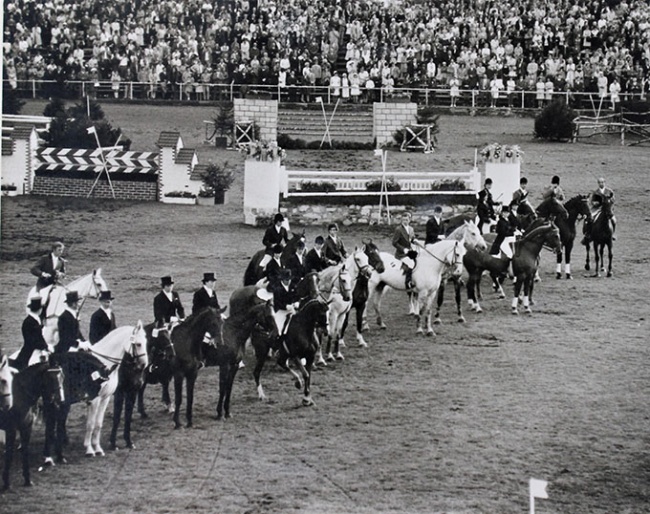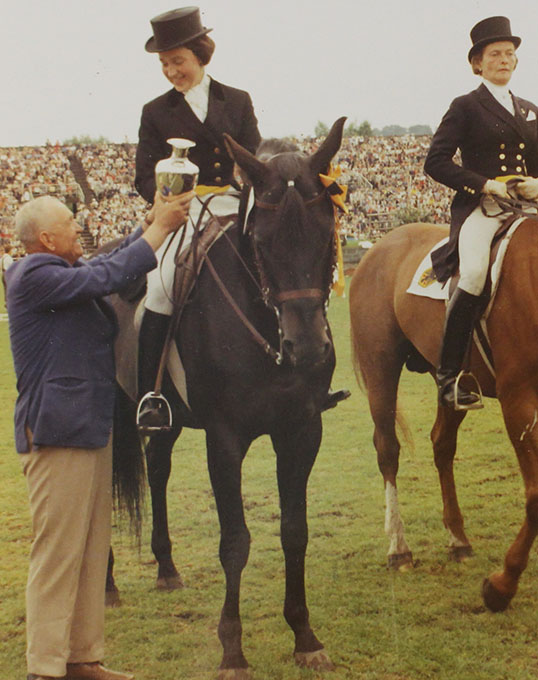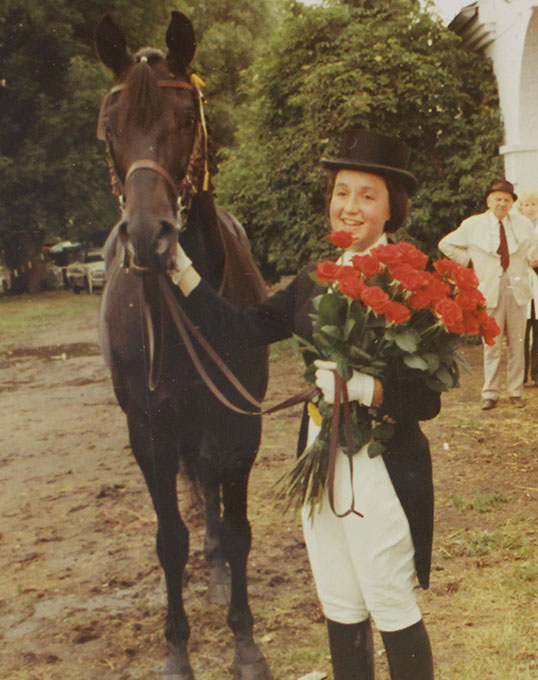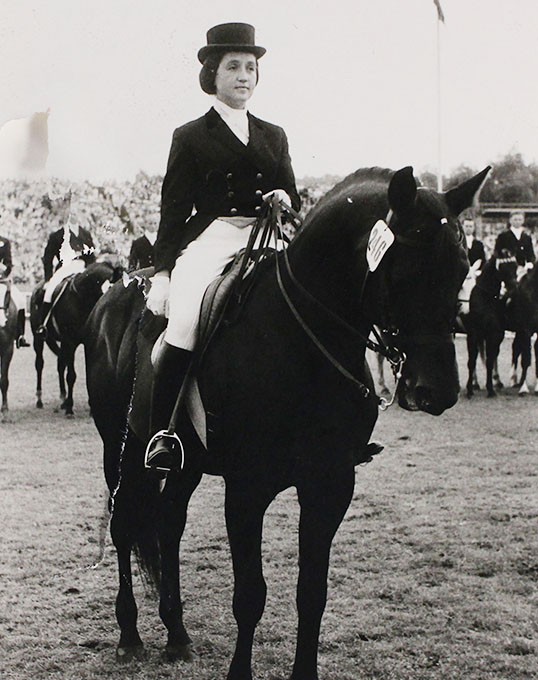
- by Silke Rottermann for Eurodressage
When Dr. Josef Neckermann and the German team had a total triumph at the first dressage World championships in Berne 1966, taking team gold and all individual medals, it was a formality to assign the next World championships to the equestrian mecca of Aachen. Embedded into the traditional CHIO, the world’s best dressage riders contested for the medals in the week of 20 - 28 July 1970. However, instead of repeating their success of 1966, the German team suffered two painful defeats on home soil, with the Soviet Union taking both gold medals.
On paper the situation seemed pretty clear before the 1970 World championships in Aachen. Since Berne 1966 Germany had won all team championships and over all did so at the last Europeans in Wolfsburg in 1969 with a remarkable lead of 190 points to the silver medalists. The latter were not the expected Soviet Union, but quite surprisingly the German Democratic Republic whose trio of riders had only started contesting with the world’s best from the Olympic Games 1968 on.
In reality the title defender’s possibilities looked bleaker than many were aware of and there was quite some stir right before Aachen.
Stir Before Aachen
Josef Neckermann’s then 15-year-old title defender Mariano had won individual Olympic silver and European bronze, but had lost his pole position. And even though the German statistic for 1970 revealed they had more than 50 horses successful at S-level, unique at that time in the world, they were still seriously short of top pairs.
After the retirement of their mainstays Dux of Dr. Reiner Klimke and Remus of Harry Boldt, the younger hopefuls Mehmed, Liostro or Van Eick were still too immature to start them at the Worlds. So the Germans saw themselves forced to pair Harry Boldt with Ilsebill Becher’s Swedish grey Silverdream who was kindly made available for the team by his rider. Only 1969 double European champion Liselott Linsenhoff and her Swedish stallion Piaff were a fixity.
Thirty-One From Nine Nations
Thirty-one participants from 9 different nations of which 6 had complete teams of three riders started in the Aachen Grand Prix. While this was an improvement to Berne four years earlier, where 24 riders from 6 nations had taken part, it was still a downfall compared to the Olympic Games two years earlier. There the USA, Canada and Chile had fielded teams which were missing at Aachen. On the other hand the two Scandinavian countries of Sweden and Denmark, which were absent in Mexico-City, returned with teams to the world stage.

(Photo © CHIO Aachen Museum)
At Aachen, just like the year before at the European championships in Wolfsburg, Switzerland only had an individual rider in the 23-year-young Christine Stückelberger who came 13th in the Grand Prix with the 12-year-old Irish bred Merry Boy.
From the 31 starters, four teams also sent individual riders beside their 3 team riders: Germany had 5 individuals and the Soviet Union, Denmark and Sweden each one.
The Title Contenders
From an individual point of view, 1969 double European champion Liselott Linsenhoff, after the war a student of the late master Otto Lörke and already 1956 double Olympic medalist, was the favorite with her Swedish stallion Piaff. The spitting image of his famous sire Gaspari, a 1960 and 1964 Olympic dressage horse for Sweden, Piaff really came into his own.
1968 Olympic individual champion Ivan Kizimov and his still only 12-year-old gelding Ikhor could also be considered serious title contenders, after they had won silver at the previous years’ Europeans.
Grand Prix Team Competition: Soviet Union Beats West Germany
The Grand Prix of the 1970 Aachen World Championships wasn’t the first competition in the FEI’s history in which 5 judges decided about success and failure, but it was the first one in which five judges were positioned not only at the short side (3), but also at both long sides (1 each) of the arena. Additionally for the first time they were not allowed anymore to compare and discuss their marks after each ride. Instead they had to submit their sheets immediately after the ride, like we know it today.
At Aachen these five judges were Mr. Franchon (France), Colonel Abé (Germany), Mr. Pot (The Netherlands), Mr. Sarasin (Switzerland) and Mr. Herrera (Mexico). So of the 6 teams contesting for medals only Germany had a judge of its own country in the jury. The judgement, perhaps because the way was done for the very first time, wasn’t always clearly in unison. For example the points awarded for the 8th of the Grand Prix differed between 257 and 319, for 13th place differed between 239 and 307 to name two striking examples.

(Photo © CHIO Aachen Museum)
While the Soviet Union’s weakest result was that of Ivan Kalita and his thoroughbred Tarif xx with 1485 points, Germany’s was Harry Boldt’s who scored just 3 points more with Silverdream. Elena Petushkova and her black Russian bred Trakehner Pepel, on the Soviet team since the Europeans 1965, managed to stay 4 points ahead of their team mates Ivan Kizimov and Ikhor. Both clearly hold Germany’s Josef Neckermann and Mariano, at bay who got more than 60 points less.
In the end it was up to favourite Liselott Linsenhoff and Piaff to ride for team gold. Both showed the very best ride on that day, the chestnut with the huge neck and his petite elegant rider in great harmony and with a lightness dressage should be all about. With 1624 points, 56 more than the 2nd placed Petushkova, Linsenhoff was the clear and convincing winner of the Grand Prix, the only rider breaking the 1600 point barrier on that day.
However, the Soviet Union was the one jubilating as they won their very first team gold in the history of FEI dressage competitions with just 2 points ahead of Germany, which understandingly was very disappointed losing team gold on home soil. It was the closest team decision ever until our days in the history of the World Championships in dressage.
East German Triumph
A triumph of its own kind was celebrated by the team of the German Democratic Republic, which was the one to take team bronze. Their anchor, Horst Köhler and the appropriately named grey gelding Neuschnee came 5th of all riders in the Grand Prix. Köhler and Neuschnee had already achieved this placing at the 1968 Olympic Games which was their international championships debut.

Brockmüller and Tristan, Horst Köhler
and Neuschnee, Wolfgang Müller and Marios xx.
(Photo © CHIO Aachen Museum)
Köhler was not only the best of the trio at Aachen, but had also trained the horse of his team mate Gerhard Brockmüller, Tristan. The late Wolfgang Müller’s thoroughbred Marios xx was the second horse of the GDR team to get into the ride-off the next day. The brown gelding was a particular elegant and light-footed appearance. All three riders from the GDR made so much of so little in the very limited time span of 5 years (1968-1972) which their state allowed them to contest with the best on the world stage. Regrettably after the 1972 Olympics in Munich where the team came 5th and did not medal, dressage as an Olympic discipline wasn’t supported by the GDR anymore from 1973 on and disappeared into insignificance until the reunion in 1990.
Sweden on the Rise
Even though there were only 6 teams, Sweden’s 4th place in the team ranking was a clear improvement to Berne four years earlier and gave a hint for the upcoming Olympics. At Aachen 1970 exactly the same ladies’ team rode who then won team bronze two years later in Munich.
All three showed very equal performances at the World Championships with the best and the worst team member just 19 points apart. The best was a new kid on the block: Ulla Hakanson and her already 13-year-old Swedish gelding Ajax.
Both had only started dressage two years earlier and were in their first Grand Prix season after the chestnut had competed as an international jumping horse before. After winning the Nordic-Baltic-championships in 1967, Ajax and Ulla were sent to Aachen. There Ajax frightened himself in the Soers and refused fences repeatedly, after which Ulla decided to switch to dressage with her horse. Their return to Aachen three years later was a triumphant one and only the beginning of a remarkable career between A and C.
Individual Competition / Ride-Off
The best 8 pairs of the Grand Prix were allowed to ride for individual medals in the so-called ‚ride-off‘ the next day. The points achieved in the Grand Prix were added to the ones of the ride-off, so the overall best of both classes was the new World Champion.

(Photo © CHIO Aachen Museum)
With almost 60 points in hand over Elena Petushkova and her stallion Pepel, Liselott Linsenhoff held the best chance to add the World title to her already impressive medal collection. Her 12-year-old Swedish stallion Piaff was considered a steady tempered, willing horse whose submissiveness and quality were out of question.
However, when Linsenhoff suffered a car accident on her way from the hotel to the showgrounds on the day of the ride-off, it was a bad omen.
Probably still distracted from the crash into a fountain, Linsenhoff went off course in her ride and it took some time until the bell rang and she could correct her way. That in turn resulted in her getting time faults for not keeping the then still existing time limit.
This was the chance for Elena Petushkova from Moscow and Pepel, quite a different type from Piaff, to overtake the German pair. They won the ride-off ahead of their team-mate Ivan Kizimov and Ikhor. Linsenhoff’s 56 points lead after the Grand Prix was not enough to compensate her mistake in the ride-off. Heartbreakingly, Linsenhoff nd Piaff lost the gold with just 2,5 points less to the charming Soviet pair who captured the heart of the spectators with their effortless and dance-like rides.
1968 Olympic champion Ivan Kizimov got individual bronze on his reliable bay gelding Ikhor and title defender Josef Neckermann came 4th of Mariano. The 1966 World Champion retired from the sport afterwards and served as schoolmaster at home for Neckermann’s grand-son Christian.
The third German rider, 1966 individual silver medalist Harry Boldt, had to be content with 7th place this time. Even though the dapple grey Silverdream was a classy horse, they were a totally new combination as such and it was quite a feat to get into the field of the best 8 under such circumstances.
The two GDR riders in the ride-off were 5th (Horst Köhler and Neuschnee) and 8th (Wolfgang Müller and Marios xx).
Best non-European rider, although she didn’t made it into the ride-off, was Canada’s just 23-year-old Christilot Hanson (Boylen) who came 11th. Known on the international scene for her partnership with her OTTB Bonheur xx with whom she debuted at the 1964 Olympics at just 17 years of age, she sat on quite theopposite type of horse in Aachen, the massive Hanoverian Armagnac with whom her trainer Willi Schultheis also celebrated quite some success.
Despite Christilot Hanson’s remarkable placing, dressage continued to remain a European affair, but this was slowly beginning to change a few years later. At Aachen 1970 Canada and the USA had both just sent two individual riders each who placed in the last third.
Breeding at the 1970 World Championships
Just like four years earlier at the first World Championships in 1966, Aachen showed a wide range of horse types which were used for dressage at the highest level at that time. In the field of 31 horses, a few pure bred thoroughbreds were still there and two of them even made it into the ride-off (Tarif xx and Marios xx). However, warmblood breeding reigned and there the Swedish breed had almost as many horses in the arena in the arena than the German ones.
The winning team of the Soviet Union sat on horses entirely bred on their territory. The 8-year-old thoroughbred black gelding Tarif xx (by Faktotum xx) was only at the beginning of his long and successful career, whereas the highly refined black Russian Trakehner stallion Pepel (by Piligrim) joined the Soviet team already in 1965 and remained there until an unbelievable ten years later. The bay gelding Ikhor was bred by Khobot in 1958 and competed first on the Soviet team at the 1964 Olympic Games when he was just 6.

(Photo © CHIO Aachen Museum)
Hanoverians continued to be the dominating dressage breed in Germany, having no less than 8 at Aachen 1970: the Swedish ridden chestnut Lucky Boy (born 1960 by Der Löwe xx) who would later also carry the Dutch flag, the 12-year-old chestnut Armagnac (by Aumund) for Canada, Lorlot (by Der Löwe xx), 10th in the Grand Prix with German individual rider Wolfgang Haug. Then Durus, ridden by German individual Werner Wilhelms and sired by Duellant, 9th in the Grand Prix. Inge Theodorescu, mother to German national coach Monica Theodorescu, showed Marzio by Marcio xx and Dr. Kurt Capellmann the tall gelding Granit by Gong. The US individual rider Louis Stephens competed on the gelding Fasching by Fronvogt.
The Hanoverian breeding’s approach at that time, often using thoroughbreds to refine their riding types, continued and with success.
Holstein had one renowned name in the field: Antoinette by Anblick xx, 1964 Olympic team champion with Dr. Neckermann, was competed by his daughter Eva-Maria as an individual.
The German Democratic Republic’s team was entirely on home-bred horses of very different type. The 14-year-old thoroughbred gelding Marios xx (by Asterios xx) was a typical representative of his breed: Highly elegant, long legged and with a certain nerve and nobility in his appearance. Quite the opposite was the 10-year-old gelding Tristan (by Ferdinand) who was a more sturdier type of warmblood, even back then. Neuschnee, the GDR’s best horse, was a 1956 born grey gelding by Markwart, an elegant, harmonious type of warmblood.
Sweden had five horses in the field: On the silver winning German team there was the grey Silverdream (by Drabant x Effendi) and the individual silver medalist Piaff (by Gaspari x Ruthven), both foaled in 1958. On their own Swedish team they were the chestnut geldings Ajax, *1957 by Jovial and the 15-year old Casanova (by Utter). Swedish individual Anders Lindgren rode Eko, another offspring of Drabant. For years earlier still on the Swedish team, the grey Helios by Jäger ox was competed by US rider Edith Master who already showed the horse at the Olympics two years earlier.
Danish individual Tove Jorck-Jorckston competed the Swedish bred mare Monique. Denmark had a flea bitten grey gelding in the field: Talisman by Baki, presented by the Gunnar Anderson student Aksel Mikkelsen. Just 24th in Aachen, this pair would make it into the individual ride-off two years later at the Olympic Games.
The British ladies team had the eighth Swedish bred horse, the bay gelding San Fernando (*1955) by Locarno who under his first name Karat had already been on Sweden’s 1964 Olympic dressage team and had competed at the Olympics 1968 under the British flag which he would do again in 1972. Great Britain itself had two horses from their breeding on the team: Pericles of Diana Mason and the thoroughbred El Guapo xx by Guersant xx. Ireland only had one horse, the thoroughbred-like Merry Boy for Switzerland.
Text © by Silke Rottermann for Eurodressage
Special thanks to Thomas Frei (Switzerland) and Dr. Doris Beaujean from the CHIO Aachen Museum for their support in making results lists and photos of the event available.
Related Links - World Championships Series
Scores: 1970 World Championships Dressage
Finally Official - The First Dressage World Championships 1966
World Championships Berne 1966 Through The Eyes Of…
References for this article
Max E. Ammann, Erinnerungen an den Pferdesport in der DDR (1. Teil):
https://www.pferdewoche.ch/news/standpunkt/article/erinnerungen-an-den-pferdesport-in-der-ddr-1-teil/ (10th July 2022)
Reiner Klimke, Frantisek Jandl, Werner Lutz, Reiterspiele Mexiko 1968, Aschendorff Verlag, Münster 1968, p. 133.
Reiner Klimke, Albert Stecken, Helmut Müller, Olympische Reiterspiele München 1972, Aschendorff Verlag, Münster 1972, p. 14-19, p. 158.
Josef Neckermann, Im starken Trab, FN-Verlag, Warendorf 1992, p. 190-201.
https://www.fei.org/history/fei-world-championships/1970-aachen-germany
Interview Christine Stückelberger on 4th June 2022.